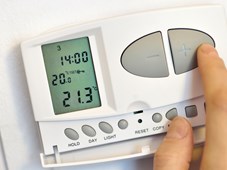IoT: Smart Homes, Software, and Switches (Part 2)
By Mike Bolduc | February 28, 2017

In part 1 of this blog, we discussed key smart home applications related to personal and family security. The second part of our smart home blog will focus on products which can provide tangible cost savings to the consumer. According to various estimates, heating, cooling, and lighting accounts for over 50% of annual energy usage in a typical US home. It’s no wonder that consumers are showing interest in technology solutions such as smart devices to manage these resources more efficiently.
Relative to heating and cooling, the most visible device in the smart home is the thermostat. These devices take information from various sensors in the home, and combined with occupancy usage patterns, make decisions on when to turn the heat or air conditioning on or off. While many of the thermostats found in high end homes use touch screens for the operator interface, a large number still use standard switches as touchscreens are expensive and can be cumbersome for the elderly and people with large fingers. Beyond the ability to withstand many cycles and be durable enough to stand up to “heavy handed” users, the tact and navigation switches used on these products must have the proper sound and feel to create the perception of a quality product to the consumer. In addition to operating the thermostat, these electro-mechanical switches can also be used for reset functions as static electricity or power surges can sometimes interrupt the operation of software managed smart thermostats or equipment interfaces. The switches used for this function need to be small, reliable, and have the ability to accommodate over-force conditions (when the operator uses a pen or small object instead of their fingers for example). While most people don’t give much thought to these little switches, if they don’t work you could end up with a lot of expensive equipment in your home that doesn’t do its job – as well as a frantic call to the local HVAC technician.
Lighting is the last major category in the smart home. No longer confined to the ubiquitous lightbulb, modern smart lighting systems can monitor occupancy in the home and the amount of natural daylight, as well as be programmed to factor in usage patterns in order to provide a balance between ambience, security, and electricity savings. Similar to smart heating and cooling devices, these smart lighting systems appeal to consumers based on their ability to provide tangible cost savings. Smart lighting products include sensors to monitor occupancy (motion) and daylight, wireless and communicating light switches, and programmable dimmers and timer modules. While all these devices may or may not be dependent on software, they all require the use of hardware such as a switch in order to operator properly. Typical operator interfaces include DIP switches for addressing wireless light switches and sensors as well as tact switches for wall modules, timers, and dimmers. The tact switches used in these applications need to have small size and high cycle life. It’s also important to be able to customize the haptics (sound and feel) to achieve the right perception of quality for the end customer.
According to the research firm Gartner, a typical US home could contain more than 500 smart devices by 2022. As with most IoT products, the software and cell phone apps generate most of the excitement. However it’s important to keep in mind the continuing role that hardware still plays in these products. The simple tact, pushbutton, and DIP switches - generally the last components to be added to the design and one of the lowest cost items on the typical bill of materials - are generally the only thing on the end product the consumer actually touches. When they work they go unnoticed - but when they don’t the results can be expensive and frustrating.

Mike Bolduc
Global Segment Manager
Industrial & Medical
